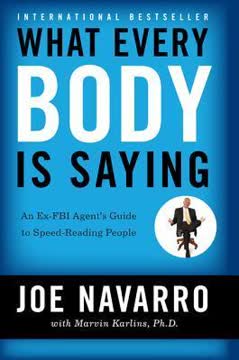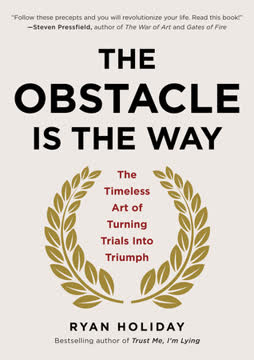Key Takeaways
1. Baselining is the Foundation of Lie Detection
Before we can pinpoint lies, we must be able to recognize truth.
Establishing a Norm. Baselining involves observing a person's behavior under normal, non-threatening conditions to understand their typical demeanor. This crucial first step allows you to identify deviations that may indicate deception or discomfort. Without a baseline, distinguishing lies from nerves becomes nearly impossible.
How to Baseline:
- Start with neutral topics like the weather or weekend plans.
- Observe physical behaviors: posture, gestures, fidgeting, facial expressions.
- Listen for verbal cues: voice tone, speech patterns, use of filler words.
- Identify how they express excitement or passion.
Nervous Baseline. It's also important to establish a "nervous baseline" to differentiate between lying and general anxiety, especially in high-pressure situations. By understanding how someone behaves when nervous but truthful, you can more accurately detect deception.
2. The Face Reveals Hidden Emotions
Human emotions are shown primarily in the face, whereas the body merely shows how one is coping with the emotion.
Microexpressions Unveiled. The face is a rich source of information, particularly through microexpressions – brief, involuntary facial expressions that reveal true emotions. These fleeting displays, often lasting only fractions of a second, are difficult to control and can expose hidden feelings.
Seven Universal Emotions:
- Happiness
- Sadness
- Anger
- Fear
- Disgust
- Surprise
- Contempt
Eye Clues. Beyond microexpressions, the eyes offer additional insights. Eye-blocking (covering or shielding the eyes) indicates discomfort, while pupil dilation can signal arousal or interest. Gazing patterns, sideways glances, and darting eyes also provide valuable information.
3. Body Language Speaks Volumes
People don’t think to control their feet, instead pouring their energy into verbal content and making their upper body presentable.
Beyond the Face. While the face is important, body language provides a wealth of information about a person's true state. Liars often focus on controlling their words and facial expressions, neglecting their body language, which can reveal inconsistencies.
Key Body Language Categories:
- Blocking Behavior: Indicates discomfort, disagreement, or disbelief.
- Pacifying Behavior: Attempts to calm oneself down or self-soothe.
Feet, Legs, and Torso. Pay attention to foot movements (tapping, direction), leg positions (crossed, splayed), and torso cues (leaning, posture) for additional insights into a person's emotions and intentions.
4. Vocal Cues Expose Deception
What we say might not be important as how we say it.
Beyond Words. Vocal displays, voice tone, and language patterns offer valuable clues to deception. Liars often exhibit specific verbal behaviors that can betray their dishonesty.
Verbal Clues to Deception:
- Delayed responses
- Answering with generalizations
- Emphasis statements ("Swear to God")
- Distancing language (avoiding pronouns)
- Non-contracted statements ("did not" instead of "didn't")
- Changes in voice tone (pitch rising or falling)
Open-Ended Questions. The most effective lie detection technique is to stay quiet and listen, asking open-ended questions to encourage the person to fill the silence and reveal inconsistencies.
5. Clusters of Red Flags Signal Deceit
There is no “smoking gun” that means someone is lying.
No Single Indicator. There is no single behavior that definitively proves someone is lying. Instead, focus on identifying clusters of "red flags" – deviations from the baseline that, when combined, suggest deception.
Common Lying Gestures:
- Frozen bodies
- Odd smiles
- Lip pursing
- Mismatched behavior (words not aligning with gestures)
- Eye blocking
- Nervous gestures (hand wringing, fidgeting)
Subconscious Reactions. Liars often exhibit subconscious reactions to their own lies, such as covering their mouth, moving back, or touching their nose.
6. Your Own Nonverbal Behavior Matters
Most people will judge you within the first second of meeting you and their opinion will most likely never change.
Beyond Observation. Understanding nonverbal communication isn't just about reading others; it's also about being aware of your own body language and how it impacts others' perceptions of you.
Key Considerations:
- Synchronicity and mimicry (subtly mirroring others' behavior)
- Angling your body (avoiding direct opposition)
- Seating choices (avoiding low or slouching positions)
First Impressions. Making a good first impression is crucial, as people often form lasting judgments within seconds. Pay attention to your handshake, posture, and overall demeanor to project confidence and authenticity.
7. Mastering Special Areas: Dating, Business, and More
Every single one of the tips from previous chapters can be applied in the business environment.
Contextual Application. The principles of lie detection and nonverbal communication can be applied to various contexts, including dating, business, and public speaking. Each area requires specific considerations and strategies.
Dating and Romance:
- Flirting behaviors (raised eyebrows, intimate gazing)
- Understanding gender differences in communication styles
- Projecting attractive body language (smiling, open posture)
Business and Interviews:
- Conducting interviews without a table for better observation
- Using confident gestures (steepling, open palms)
- Exposing palms and hands as much as possible when dealing with potential customers
Public Speaking:
- Avoiding aggressive gestures (pointing)
- Making broad eye contact with the audience
- Moving beyond the lectern to engage the audience
Last updated:
FAQ
What's "Human Lie Detection and Body Language 101" about?
- Overview: "Human Lie Detection and Body Language 101" by Vanessa Van Edwards is a guide to understanding and interpreting nonverbal behavior to detect lies and improve communication.
- Focus Areas: The book covers topics such as microexpressions, body language, vocal tone, and language patterns to help readers decode hidden emotions and detect deception.
- Practical Application: It provides scientifically-backed techniques and practical advice for various contexts, including personal relationships, business interactions, and interviews.
- Target Audience: The book is intended for anyone interested in improving their communication skills, from professionals to everyday individuals.
Why should I read "Human Lie Detection and Body Language 101"?
- Improve Communication: The book offers tools to enhance your ability to read nonverbal cues, leading to more effective and honest interactions.
- Detect Deception: Learn to spot lies and hidden emotions, which can be crucial in personal and professional settings.
- Scientific Basis: The techniques are grounded in academic research, providing reliable methods for lie detection and understanding body language.
- Versatile Use: Whether you're a teacher, manager, or parent, the skills taught in the book can be applied to various aspects of life.
What are the key takeaways of "Human Lie Detection and Body Language 101"?
- Nonverbal Dominance: Up to 93% of communication is nonverbal, emphasizing the importance of understanding body language.
- Baselining: Establishing a person's baseline behavior is crucial for detecting deviations that may indicate lying.
- Microexpressions: Recognizing universal facial expressions can reveal true emotions, even when someone is trying to hide them.
- Clusters of Clues: No single gesture indicates lying; look for clusters of red flags to make more accurate assessments.
How does baselining work in lie detection?
- Definition: Baselining involves observing how someone behaves under normal, non-threatening conditions to identify their truthful behavior.
- Steps: Start with neutral topics to establish a baseline, noting physical and verbal behaviors such as posture, gestures, and voice tone.
- Comparison: Use the baseline to detect deviations when discussing more sensitive or important topics, which may indicate deception.
- Nervous Baseline: Consider how someone behaves when nervous but truthful to differentiate between anxiety and lying.
What are microexpressions, and why are they important?
- Definition: Microexpressions are brief, involuntary facial expressions that reveal true emotions, often occurring in 1/15 to 1/25 of a second.
- Universal Expressions: There are seven universal microexpressions: disgust, anger, fear, sadness, happiness, surprise, and contempt.
- Detection: Learning to recognize these expressions can help you understand hidden emotions and detect lies.
- Practice: The book suggests practicing these expressions in the mirror to better identify them in others.
How can body language indicate deception?
- Feet and Legs: Liars often forget to control their feet, which may point towards exits or jiggle when nervous.
- Torso and Arms: Leaning away, crossing arms, or touching the neck can indicate discomfort or deceit.
- Facial Clues: Incongruous facial expressions, such as a smile with angry eyes, can be red flags.
- Clusters: Look for multiple signs of nervousness or blocking behavior to identify potential lies.
What role does vocal tone play in lie detection?
- Voice Changes: Liars may exhibit changes in pitch, such as a higher pitch for women and a lower pitch for men.
- Speech Patterns: Liars often use more words, avoid contractions, and provide excessive details to convince others.
- Delayed Responses: Hesitation or repeating questions can indicate stalling for time to fabricate a lie.
- Distancing Language: Avoiding pronouns or using vague terms can be a sign of deception.
What are some common lying gestures?
- Frozen Bodies: Liars may freeze their upper bodies due to fear and the limbic response.
- Lip Pursing: This gesture often indicates holding back information or disagreement.
- Eye Blocking: Squinting or rubbing eyes can show discomfort with what is being said or heard.
- One-Sided Expressions: Asymmetrical facial expressions, like a one-sided smile, can indicate contempt or deceit.
How can I use the techniques in "Human Lie Detection and Body Language 101" in everyday life?
- Personal Relationships: Improve trust and communication by understanding nonverbal cues and detecting lies.
- Professional Settings: Use body language skills in interviews, negotiations, and meetings to gain insights and build rapport.
- Parenting: Recognize when children might be hiding something or feeling uncomfortable.
- Social Interactions: Enhance your ability to connect with others by reading their true emotions.
What are the best quotes from "Human Lie Detection and Body Language 101" and what do they mean?
- "Lie spotting is about getting back to truth." This emphasizes the book's goal of fostering honest interactions rather than simply identifying liars.
- "Our brain is much more adept at spotting lies than we realize." Highlights the innate ability to detect deception, which can be honed with practice.
- "There is no behavioral smoking gun that means a subject is lying." Stresses the importance of looking for clusters of clues rather than relying on a single indicator.
- "Learning to decode human behavior will completely change the way you interact and listen to others." Encourages readers to embrace the transformative power of understanding nonverbal communication.
How can I make a great first impression using body language?
- Handshakes: A firm, straight handshake conveys confidence and equality.
- Posture: Stand straight with your head up and shoulders back to project confidence.
- Smile Appropriately: Smile at key moments, such as greetings and farewells, to appear friendly but not submissive.
- Minimize Distractions: Carry only one bag and remove outerwear to appear organized and focused.
What are some special considerations for using body language in business?
- Interviewing: Use glass tables to observe candidates' feet and sit at an angle to reduce tension.
- Sales: Show your palms to convey openness and avoid barriers like desks during pitches.
- Public Speaking: Use broad gestures and eye contact to engage the audience and avoid pointing, which can seem aggressive.
- Confidence Gestures: Use steepling and take up space to project confidence in meetings and negotiations.
Review Summary
Human Lie Detection and Body Language 101 receives mostly positive reviews, with readers finding it informative and useful for beginners. Some appreciate the explanations behind expressions and nonverbal cues. Critics note that much of the information is instinctual or not new. The book is praised for its simplicity and accessibility, making it a good starting point for those interested in body language and lie detection. Readers value the practical tips and insights provided, though some find it brief and lacking depth compared to more comprehensive works on the subject.
Similar Books
Download PDF
Download EPUB
.epub digital book format is ideal for reading ebooks on phones, tablets, and e-readers.











